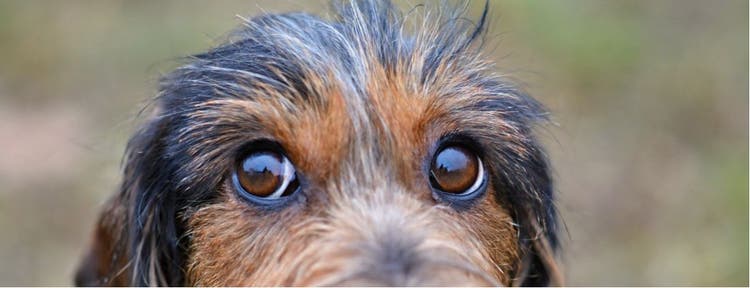
Keep an Eye Out for These Common Eye Conditions in Dogs
One of the most common dog health misconceptions is that man’s best friend only sees in black and white. In fact, a dog’s vision is similar to that of a human with red-green colorblindness. They can see in color, but have trouble seeing red and green, distinguishing between shades of grey, and observing changes in brightness. In other respects, however, their eyes are even stronger than humans. An enhanced ability to notice changes in motion has helped many dog breeds evolve into expert hunters and scavengers.
It’s important to take your dog’s eyes into account as you provide for their healthcare needs. Dogs are susceptible to a number of the same eye conditions as humans, as well as several canine-specific ailments. In most cases, proactivity is essential for alleviating symptoms quickly and avoiding more severe consequences.
6 Eye Conditions to Watch For
Cataracts
Cloudy or milky eyes are the telltale sign of this eye condition, which can lead to severe and permanent vision loss over time. When the lens of the eye becomes cloudy, it blocks light from passing all the way through and makes it difficult to see clearly. While they’re a common concern for aging dogs, your veterinarian may be able to operate and restore your pup’s vision.
Cherry Eye
One of the biggest differences between a dog’s eye and a human’s is that dogs have a third eyelid. You haven’t seen it? That’s because it’s typically hidden in the inner corner of the eye. There, it houses a tear-producing gland that can begin to protrude when the ligaments holding it in place get weaker. The condition is genetic — if it’s affecting one eye, it’ll probably affect the other before long — and easily treatable with simple surgery.
Conjunctivitis
Conjunctivitis (“pink eye”) occurs when the mucus membrane lining the eyelid becomes inflamed. While conjunctivitis can easily spread between humans, it’s unlikely that you’ll get it from your dog. PetMD still recommends washing your hands before and after handling an affected animal. They also make it clear that pet owners should consider conjunctivitis as a symptom rather than a condition unto itself. “Many conditions,” PetMD writes, “cause conjunctivitis in dogs including physical irritation, infections, and allergic reactions.” Watch out for symptoms like swollen eyelids, redness, and discharge, and reach out to your veterinarian if they’re persistent.
Damage to the Cornea
Dogs are curious critters known to poke their snouts just about anywhere. This can leave them vulnerable to corneal injuries from sharp objects, tree branches, dirt, and other debris. A dog may even exacerbate an injury to the surface of their eye by attempting to dislodge a foreign object with their paw. Watch out for squinting and excessive pawing at the eye. Your vet may provide antibiotic eye drops to prevent infection or recommend surgery in more severe instances.
Glaucoma
The eye is a complex organ and running effectively means consistently producing and draining fluids. Dogs and humans develop glaucoma when excessive pressure disrupts these essential processes. In the short-term, this can lead to discomfort, redness, excessive tears, cloudiness, and swollen tear glands. Over time, these symptoms can lead to vision loss and even total blindness. Act quickly to ensure you and your veterinarian can address glaucoma proactively and safeguard your dog’s eye health.
Keratoconjunctivitis (KCS)
Popularly known as “dry eye,” KCS occurs when your dog’s tear glands aren’t working effectively. In addition to discomfort, a lack of tears can lead to serious eye health concerns like corneal ulcers. Veterinarians can prescribe medicated eye drops for milder cases, but surgery may be necessary if KCS is particularly severe or persistent.
Supporting Your Dog’s Eye Health
Ask your doctor how to keep your own eyes strong and they’ll recommend getting plenty of nutrient-rich foods like blueberries, kale, carrots, sweet potatoes, and pumpkin. Packed with vital nutrients like vitamins A and E, they promote a healthy eye from the lens to the retina. They’re all great for your dog as well. Choosing foods that blend fruits and vegetables with high-quality protein can help ensure your dog’s diet benefits their entire body.
Dr. Martin Coster, a veterinary ophthalmologist from Boston, reminds dog lovers that, when it comes to eye health, “the most important preventative step is periodic examinations by your veterinarian.” If you expect your dog is suffering from any of the conditions mentioned above, contact your vet as soon as possible to pursue an effective course of action.